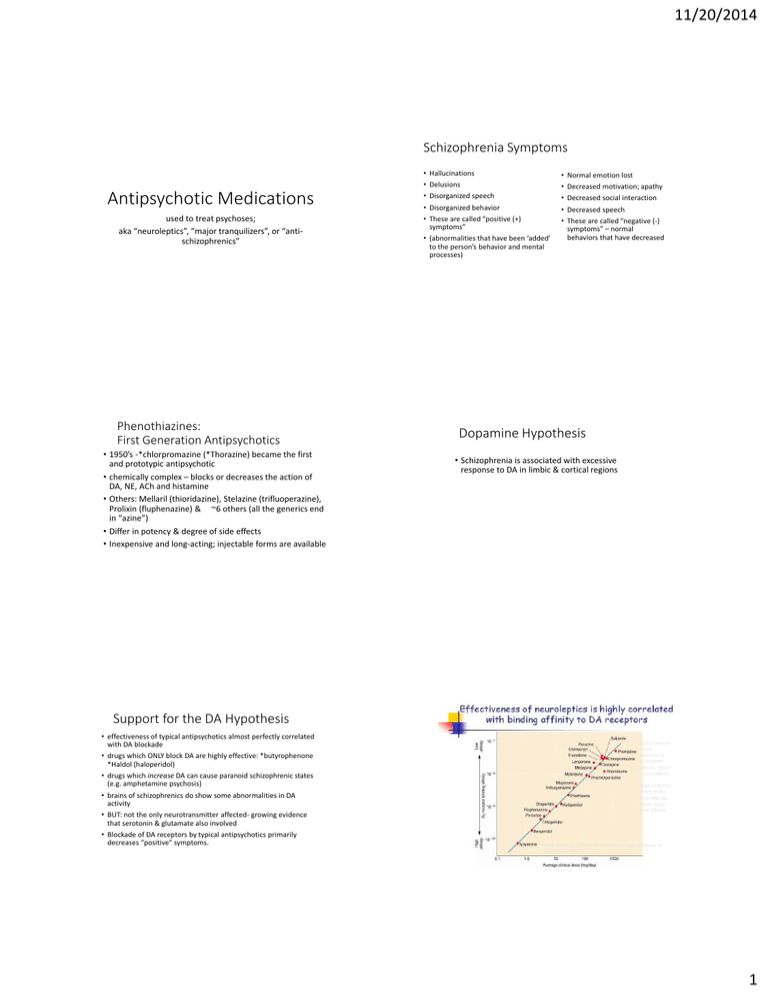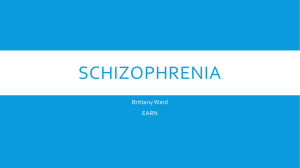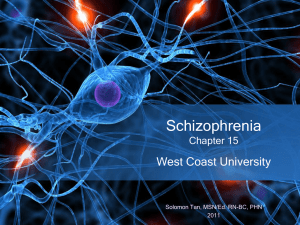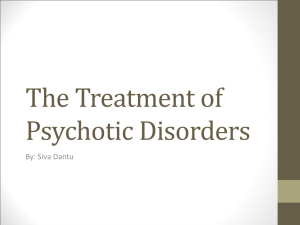Antipsychotic Medications 11/20/2014 Schizophrenia Symptoms
advertisement

11/20/2014 Schizophrenia Symptoms Antipsychotic Medications used to treat psychoses; aka “neuroleptics”, “major tranquilizers”, or “antischizophrenics” Phenothiazines: First Generation Antipsychotics • 1950’s -*chlorpromazine (*Thorazine) became the first and prototypic antipsychotic • chemically complex – blocks or decreases the action of DA, NE, ACh and histamine • Others: Mellaril (thioridazine), Stelazine (trifluoperazine), Prolixin (fluphenazine) & ~6 others (all the generics end in “azine”) • Differ in potency & degree of side effects • Inexpensive and long-acting; injectable forms are available • Hallucinations • Delusions • Disorganized speech • Disorganized behavior • These are called “positive (+) symptoms” • (abnormalities that have been ‘added’ to the person’s behavior and mental processes) • • • • • Normal emotion lost Decreased motivation; apathy Decreased social interaction Decreased speech These are called “negative (-) symptoms” – normal behaviors that have decreased Dopamine Hypothesis • Schizophrenia is associated with excessive response to DA in limbic & cortical regions Support for the DA Hypothesis • effectiveness of typical antipsychotics almost perfectly correlated with DA blockade • drugs which ONLY block DA are highly effective: *butyrophenone *Haldol (haloperidol) • drugs which increase DA can cause paranoid schizophrenic states (e.g. amphetamine psychosis) • brains of schizophrenics do show some abnormalities in DA activity • BUT: not the only neurotransmitter affected- growing evidence that serotonin & glutamate also involved • Blockade of DA receptors by typical antipsychotics primarily decreases “positive” symptoms. Low potencymore sedation & autonomic effects; fewer motor effects High potencymore motor side effects, fewer body side effects High potency – more motor effects, less sedation & autonomic effects 1 11/20/2014 Dopamine pathways involved in schizophrenia Main Side Effects • *Extrapyramidal Motor Disorders • Dry mouth, blurred vision, constipation • Sedation, decreased response to stimuli • Postural hypotension • Disturbed hypothalamic functions; skin photosensitivity • As with mood stabilizers, side effects can lead to significant noncompliance. Mesocortical system: Negative symptoms Nigrostriatal system: Extrapyramidal disorders Mesolimbic system: Positive symptoms Tuberoinfundibular System: Neuroendocrine symptoms Extrapyramidal Motor Effects • Parkinson’s-like decreased movement (akinesia) in over 30% • involuntary movements of face & limbs (dyskinesia) in 20% • compulsive restlessness (akathisia) in 20% (2) & internal, emotional sense of agitation • sometimes strong involuntary muscle spasms (dystonias) (2%) • often must take drugs like Artane, Cogentin to treat motor side-effects Second Generation (SGA) or “Atypical” Antipsychotics • Prototype: Clozaril (clozapine) (1989) • Block selected D2 & 5HT2 receptors • Fewer extrapyramidal side effects • Helped 30-33% previously unresponsive patients • Improved “negative” symptoms and disorganization; largest decrease in suicides • Side effect: wt. gain, constipation, sedation • BUT can cause deadly agranulocytosis in 1-2% so requires blood monitoring Tardive Dyskinesia (TD) • Neurological symptom that may appear after months of use.More common the longer the use, the higher the dose or the older the patient. • Involuntary movements of lips, tongue, jaw, face, eyelids &, less often, the body • Unlike other extrapyramidal symptoms, TD may increase if drug is discontinued (may be long-lasting or permanent in some) http://www.youtube.com/watch? v=BRbjRctgj_k More Atypical Antipsychotics • risperidone (Risperdal) • olanzapine (Zyprexa) • quetiapine (Seroquel) • ziprasidone (Geodon) • lurasidone (Latuda) But may cause wt. gain, high blood sugar, & diabetes Warning: increased risk of death when used for dementia-related psychosis in elderly • aripiprazole (Abilify) may be “new generation” – not a DA blocker Must weigh side effects/risks against cost 2 11/20/2014 Neuroleptic Malignant Syndrome Some will still have EPS • Medical emergency - possibly life-threatening event in 1-2%; may not be recognized • severe rigidity, may not be able to swallow or speak or move eyes • catatonia, confusion, agitation, or coma possible • autonomic effects, high fever; unstable vitals • Antipsychotics must be stopped; need to be in ICU to control vitals • http://www.youtube.com/watch?v=7IdQtYmgqDQ Other Uses for Antipsychotics • • • • • • • • Other psychotic conditions Bipolar disorder; add-on for depression, anxiety Borderline personality disorder As an add-on for treatment of major depression & some anxiety disorders (OCD, PTSD) Some developmental disorders like autism Symptoms of Huntington’s Disease & Tourette syndrome Treat aggression, agitation, delusions of dementia anti-nausea, anti-itching (e.g. Compazine) • http://www.radiolab.org/blogs/radiolab-blog/2011/aug/09/damn-it-basal-ganglia/ • treat intractable hiccups; slow premature ejaculation • preanesthetic calming 3







